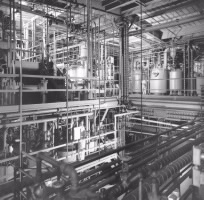FOR IMMEDIATE RELEASE | June 12, 2008
Pfizer’s work on penicillin for World War II becomes a National Historic Chemical Landmark
The development of deep-tank fermentation by Pfizer —– which enabled the mass production of penicillin for use in World War II —– was designated a National Historic Chemical Landmark by the American Chemical Society (ACS) in a special ceremony in Brooklyn, N.Y., on June 12, 2008.
Thomas H. Lane, Ph.D., president-elect of the Society, presented a commemorative plaque to Jeffrey B. Kindler, Chairman and Chief Executive Officer of Pfizer Inc. “The ACS has recognized only 61 chemical landmarks since the inception of the program in 1993,” said Dr. Lane, who is Director, Global Science and Technology Outreach and Senior Research Scientist, at Dow Corning Corporation. “This makes the award to Pfizer a mark of distinction for contributions that reach far beyond the boundaries of scientific practitioners, touching many lives over many decades.”
“We are proud to receive this designation, which honors the company’s heritage of finding unique answers to new challenges,” Mr. Kindler said. “Charles Pfizer and Company began nearly 160 years ago as a family-owned business right here in Brooklyn, and the breakthroughs recognized by this award reflect the spirit of innovation and the commitment to patients for which Pfizer is now known worldwide.”
Though penicillin was discovered by Alexander Fleming in England in 1928, he couldn’t figure out a way to produce enough for medical use, and penicillin remained nothing more than a laboratory curiosity. In the late 1930s, with the onset of World War II, scientists saw potential to resurrect Fleming's work to make a germ-killing medicine to save the lives of Allied soldiers. In 1941 the U. S. and British governments issued a challenge to the American pharmaceutical industry: Develop a way to mass produce penicillin to help the soldiers.
Each company chose a different method. Charles Pfizer & Co. —– a relatively small chemical company based in Brooklyn —– gambled on fermentation, drawing from the unique expertise it developed 20 years earlier to mass produce citric acid.
Citric acid is a key ingredient in foods and beverages —– notably soft drinks. It is a natural preservative that adds a pleasantly acidic or sour taste. Charles Pfizer & Co had made citric acid the traditional way since 1880: from unripe citrus fruit, mainly imported from Italy, but World War I interfered with the supply. In 1917 Pfizer hired James Currie, a food chemist, who had the daring idea of producing citric acid without using citrus. Currie knew that fermentation of a fungus, or mold, called Aspergillis niger could convert sugar into citric acid. Currie also understood that Aspergillis niger is aerobic, meaning it needs air to grow.
Aided by Jasper Kane, his precocious 16-year-old laboratory assistant from Brooklyn, Currie tried to grow the mold in a large flat pan purchased at the five-and-ten, but had limited success. He cut the pan into smaller, shallower pans, and immediately increased the yield. Still, the process was unpredictable and subject to a number of difficult variables: The quality of the mold spores, the purity of the cultures, contamination of air and the medium, humidity and temperature, and many others.
Currie plugged on, and in 1919 Pfizer opened a pilot plant using his fermentation process, named SUCIAC —“Sugar Under Conversion to Citric Acid.” By the mid-1920s the output of citric acid using fermentation far outpaced the production from lemons and limes. The price of citric acid, $1.25 a pound in 1919, dropped to 20 cents.
Pfizer began applying fermentation to other products, such as gluconic acid (used as a food preservative and cleanser) and ascorbic acid (Vitamin C), and experimented with innovative technologies to increase the yields. Eventually the company began to use a fermentation process in deep tanks rather than shallow pans and flasks.
Pfizer’s technological advances in using deep tanks for fermentation proved critical when Allied governments sent out the call for penicillin. Initially, Pfizer researchers, led by Jasper Kane, used shallow flasks and pans like those that were used for citric acid, and they made gradual progress in improving penicillin’s potency and purity. The breakthrough came when Kane suggested a different approach: the deep-tank method that proved successful for gluconic acid. They needed huge tanks that could hold thousands of gallons of “fermentation liquor.” Pfizer purchased an old ice plant in Brooklyn that had the necessary refrigeration equipment and converted it into a penicillin factory which opened on March 1, 1944.
The plant contained fourteen 7,500-gallon tanks and soon the company was producing more penicillin in one month than it had in all of 1943. Most of the penicillin that went ashore with Allied forces on D-Day came from Pfizer’s Brooklyn facility.
After World War II, Pfizer applied its deep-tank fermentation to manufacture streptomycin [a National Historic Chemical Landmark], an important antibiotic discovered by Dr. Selman Waksman and colleagues at Rutgers, and then to Terramycin®, the first antibiotic developed exclusively by the company’s scientists. Terramycin, which proved effective against a wide range of deadly bacteria, was developed from a microorganism in soil from the American Midwest (“Terramycin” is derived from the Latin for “earth fungus”).
The American Chemical Society established the National Historic Chemical Landmarks program in 1992 to recognize seminal historic events in chemistry and to increase public awareness of the contributions of chemistry to society. Designations through the prestigious program have included the invention of Bakelite®, the discovery of penicillin and streptomycin, the development of Tide laundry detergent, and the work of historical figures, including Joseph Priestley, Antoine Lavoisier, and George Washington Carver, among others. For more on the Landmark program, please visit www.acs.org/landmarks.
—Judah Ginsberg


